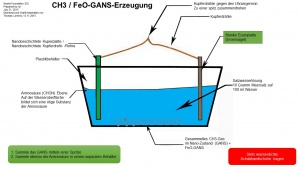CH3 GANS
Produzione
Il GANS di CH3 viene prodotto utilizzando una piastra di ferro zincato (o una bobina) in combinazione con una bobina o piastra di rame nano-rivestita. I due metalli sono collegati insieme con un filo di rame. A differenza della produzione di GANS di CO2, è possibile utilizzare una quantità molto piccola di corrente continua e una pompa per acquario (aeratore) per accelerare il processo di produzione, ma la pompa non è obbligatoria. All'inizio, ci sarà una reazione tra lo zinco e il rame nano-ricoperto, dopo un po 'inizierà la reazione tra il ferro e il rame nano-ricoperto. È possibile utilizzare un dispositivo CC comune e regolabile, che produce una corrente di circa 15 mA tra le due piastre metalliche anziché la connessione di un filo di rame. Se lo fai, il polo negativo del dispositivo è collegato alla bobina o piastra di rame nano-rivestito e il polo positivo del dispositivo è collegato al ferro. È inoltre possibile utilizzare una batteria da 1,5 V come fonte di alimentazione. Se si utilizza qualsiasi tipo di corrente, si dovrebbe aerare la soluzione salina con una piccola pompa per il serbatoio del pesce. Ci vorranno solo poche ore per produrre uno strato bruno rossastro di GANS di CH3 sul fondo del contenitore. Per ottenere un risultato migliore, è possibile montare una bobina di una ventola PC tra le due piastre anziché un filo o una sorgente di corrente. (ATTENZIONE: non toccare mai GANS con nessuna parte del corpo).
Materiali richiesti:
- Contenitore di plastica
- Piastra o filo di ferro zincato (ad esempio rete di pollo)
- Bobina o piastra in rame nano-rivestito
- 100 grammi di sale marino (10% dell'acqua utilizzata)
- 1 litro di acqua distillata
CH3 GANS Uses/Application
CH3 GANS water will strongly energize the body and is nutritious. For instance, 8 drops of CH3 GANS water combined with 1 drop of ZnO GANS water and 1 drop of CO2 GANS water will yield the following results: The plasmatic fields of CH3 GANS water gives energy to the body while the plasmatic fields of the ZnO GANS water support the nervous system. The plasmatic fields of the CO2 GANS water acts on muscles and the nervous system. The carbon within CH3 and CO2 GANS waters release energy while the hydrogen of the CH3 GANS water and the oxygen of CO2 GANS water combine to provide moisture, which is needed in the body. The energy of the hydrogen of the CH3 GANS water becomes food for the body. The ZnO GANS water supports nerve connections that are needed to assimilate energy into the body. To assure the application is effective, always add one drop of amino acid of each type of GANS to your drop mixture. The amino acid builds up on the top of the salt water solution during the production of each of the GANS' (see Amino Acids).
Every time you want to apply CH3 GANS liquid as food you must add amino acids. The amino acids tell the body that the energy is provided for the body. The GANS and the amino acids are created within the same container and therefore have an inner connection regarding their inner structure. This inner connection is necessary for the fields of the GANS and its information, which are available within the GANS water and the liquid plasma, to be transferred to the molecules of the cells of a living body. Procedures are topics of present and future research. CH3 GANS is also necessary for technical energy production.


